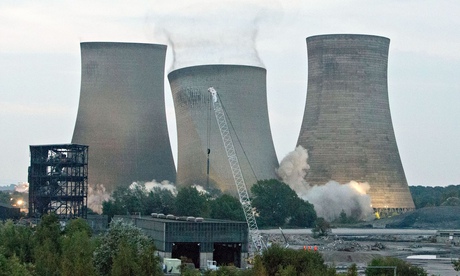
At 5am on Sunday morning, hundreds of people turned out before dawn to watch the cooling towers of Didcot A power station in Oxfordshire come down in controlled explosions. A 3,000-signature petition had recently done the rounds in the area – not against the demolition, but against the 5am timing, intended to deter the public from looking on. Demolition, it’s clear, is a popular spectator sport.
The footage of the towers collapsing is extremely compelling. They seem to leave a ghost image of themselves in the sky as they sink; or they seem to languorously blow their own smoke rings as they go down.
No onlooker was injured, but part of the appeal of watching a demolition might lie in the risk. Among the many clips of buildings being blown up on YouTube is one showing the destruction of a factory at OP Prostějov in the Czech Republic. A single lump of stone, apparently bent on avenging the destruction of the building, flies missile-like towards a couple in the watching crowd. It misses them by inches, and someone emits a fascinatingly neutral “Oh” as it scorches past.
In 1993 a female spectator was killed by masonry flying from a blown-up block of flats in the Gorbals, Glasgow, though this didn’t stop the organisers of the Commonwealth Games floating the idea of blowing up three more unpopular tower blocks in the city as part of the opening ceremony.
In the immediate postwar years, out-with-the-old-in-with-the-new demolition footage appeared regularly on newsreels, and the structures being flattened were two-up-two-down terraces. Today the footage is on YouTube and the structures are the tower blocks that replaced the terraces. Some of the watchers in those earlier decades – the technical elite – had 8mm cameras on tripods. Today, almost everyone brings a smartphone, and so the demolition is no longer a one-off event. We have our own portable calamity, to be re-played – instead of smashing a bottle, perhaps – when we want to let off steam.
But unless you’re a committed environmentalist, I don’t think there’s much catharsis in the loss of a coal-fired power station. The appeal of the spectacle goes deeper. The morbid interest lies partly in the emptiness of the condemned structure.
See the 1998 destruction of the 29-storey JL Hudson department store in Michigan. Around 20,000 people watched the live event, the largest-ever implosion of a building other than by terrorists. Before it falls, the store looks full of memories, profoundly haunted. The ghost story writer Sheridan Le Fanu had a lifelong fear of being inside a massive brick-built house as it collapsed, and when he died in bed of a heart attack in 1873, with a shocked expression on his face, his doctor observed, “that building fell at last”. Here is the salutary lesson of a demolition. If those vast cooling towers can be turned so quickly to dust, what chance do we onlookers have?

